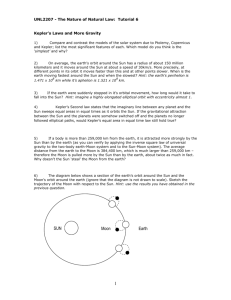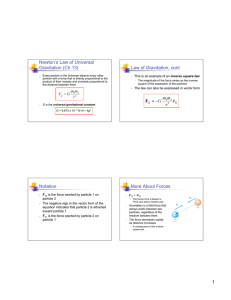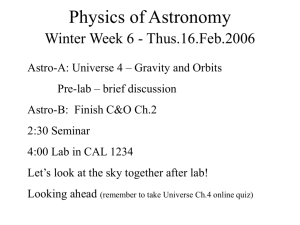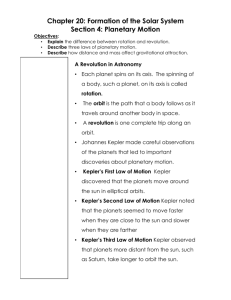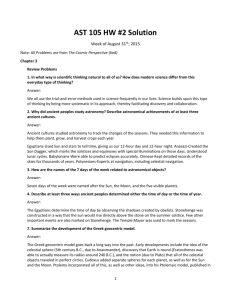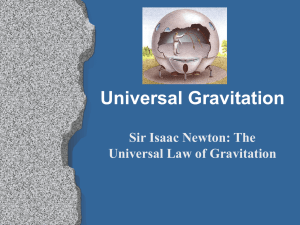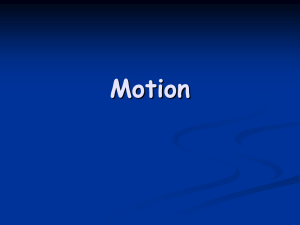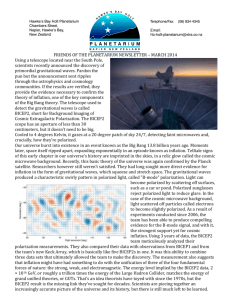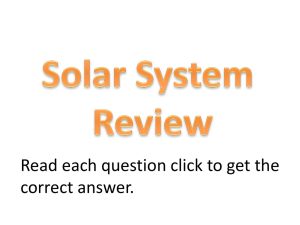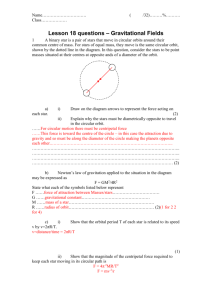lecture06
advertisement
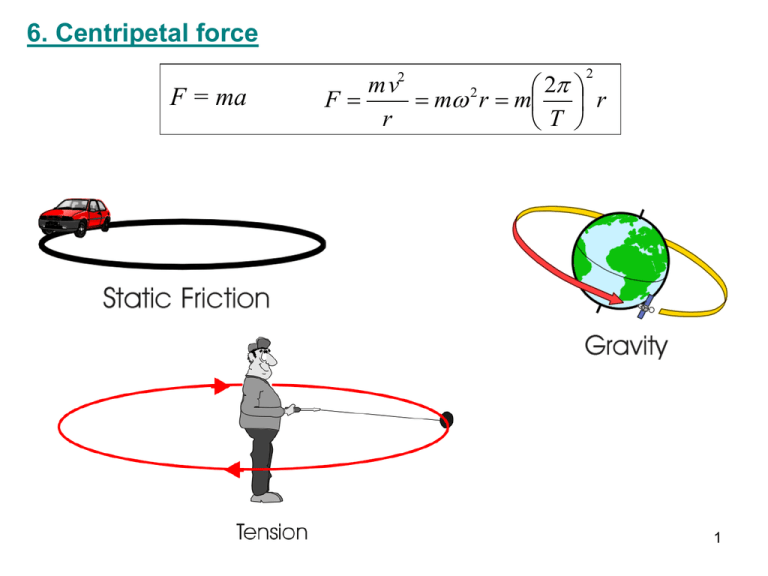
6. Centripetal force mv2 2 2 F m r m r r T 2 F = ma 1 Example: A stone of mass m sits at the bottom of a bucket. A string is attached to the bucket and the whole thing is made to move in circles. What is the minimum speed that the bucket needs to have at the highest point of the trajectory in order to keep the stone inside the bucket? m v2 m v2 m v2 F N mg N mg r r r N min 0 vmin gr 2 Examples (centripetal force) (1) N mg (2) N F = ma 2 m v2 F r 2 mv N mg r mv N mg r m v2 N mg r m v2 N mg r mg (3) N 2 mg mv m g N r m v2 N m g r 3 Question 1: The ball whirls around a pole. In what direction does the net force on the ball point? 1) toward the top of the pole 2) toward the ground 3) along the horizontal component of the tension force 4) along the vertical component of the tension force 5) tangential to the circle The vertical component of the tension balances the weight. The horizontal component of tension provides the centripetal force that points toward the center of the circle. Question 2: A particle moves at a constant speed along the presented trajectory. Compare the magnitude of the acceleration A of the particle at points A and B. T mg B Question 3: A ball is going around in a circle at constant speed. What is the angle between the acceleration vector and the velocity vector of the ball? A) 0 B) 45 C) 90 D)180 4 Newton’s Law of Gravitation Gm1m2 Fg r2 m1 m2 r F 2 on 1 F 1on 2 Gravitational constant: G 6.671011 N m2 / kg 2 Gravitational force: • one of the fundamental forces of nature • always attractive • exist between any two objects and always act along the line joining the two objects • one of the fundamental forces acting in our galaxy and the main force of interaction between the sun and planets including Earth 5 1. Determining the value of G For determining of G, Henry Cavendish in 1798 used an instrument called a torsion balance. A modern version of the Cavendish torsion balance is shown below. G Fg r 2 m1m2 6 2. Weight and Law of Gravitation The weight of a body is the total gravitational force acting on that body Consider an object near the surface of the earth: Mm Fg G 2 mg r M g G 2 r Fg What happened if the object will move far from the earth? 7 Question 1: The mass of the earth is 81 times the mass of the moon. The magnitude of the gravitational force of Earth on the Moon is __ times the magnitude of the gravitational force of the Moon on the Earth. A. 81 B. 812 C. 1 D. 1/81 E. (1/81)2 1. 2. 3. 4. 5. Question 2: The direction of the net gravitational force on m due to the two masses M is ___. up down to the right to the left There is no net force on m Question 3: The planet Saturn has 100 times the mass of Earth. Saturn is 10 times further from the Sun than Earth is. The magnitude of the acceleration of Earth in its orbit around the Sun is ___times the acceleration of Saturn. A. 100 B. 10 C. 1 D. 1/10 E. 1/100 Question 4: RMoon REarth 0.273 M Moon M Earth 0.0123 g Moon g Earth ? A. B. C. D. 0.06 0.17 0.39 0.62 8 3. Orbits of planets and satellites (Fundamentally important application of Newton’s Mechanics) •Copernicus in 1543 proposed that the sun was the center of the Solar System with the planets moving in circular orbits. •In 1619 Kepler showed that planets followed elliptical orbits using huge amount of high quality data gathered by Tycho Brahe by naked eye astronomy. •Kepler characterized planetary orbits using “Kepler’s Three Laws”. •In 1683 Newton showed that Kepler’s laws follow from his “Law of Gravity” and his “Three Laws of Mechanics”. 9 3a. Circular Orbits mE m m v2 G 2 r r Velocity: Period: GmE v r 2r 2r 3 / 2 T v (GmE )1/ 2 Example: We want to place 2000-kg satellite into a circular orbit 400 km above the earth’s surface. For the earth: RE = 6380 km, mE = 5.971024kg. v Gm E r (6.67 10 11 N m 2 / kg 2 )( 5.97 10 24 kg ) 7664 m / s 6 6 (6.38 10 0.4 10 )m 2r 2 (6.78106 m) T 5556s 92.6 min v 7664m / s 10 3b. Satellites Orbits vcircular GmE / r vescape 2GmE / r vcircular 7.9 km/s If r = RE = 6380 km then vescape 11.2km/s Trajectories of a projectile launched from point A in the direction AB with different speeds: 7) hyperbolic orbit: v > vescape 6) parabolic orbit: v = vescape 5) elliptical orbit: vescape>v >vcircular 4) circular orbit: 1,2,3) elliptical orbit: v = vcircular v < vcircular 11 Question: The Moon does not crash into Earth because: 1) it’s in Earth’s gravitational field 2) the net force on it is zero 3) it is beyond the main pull of Earth’s gravity 4) it’s being pulled by the Sun as well as by Earth 5) none of the above The Moon does not crash into Earth because of its high speed. If it stopped moving, it would, of course, fall directly into Earth. With its high speed, the Moon would fly off into space if it weren’t for gravity providing the centripetal force. 12

